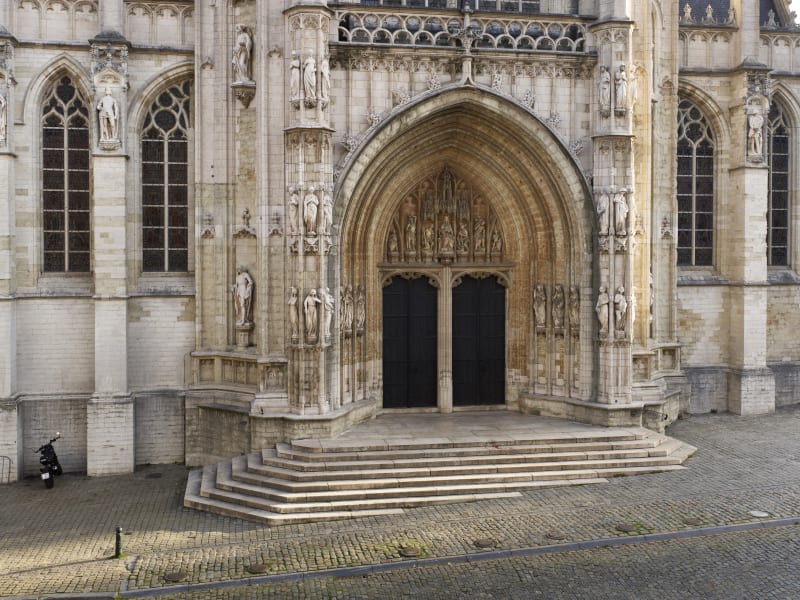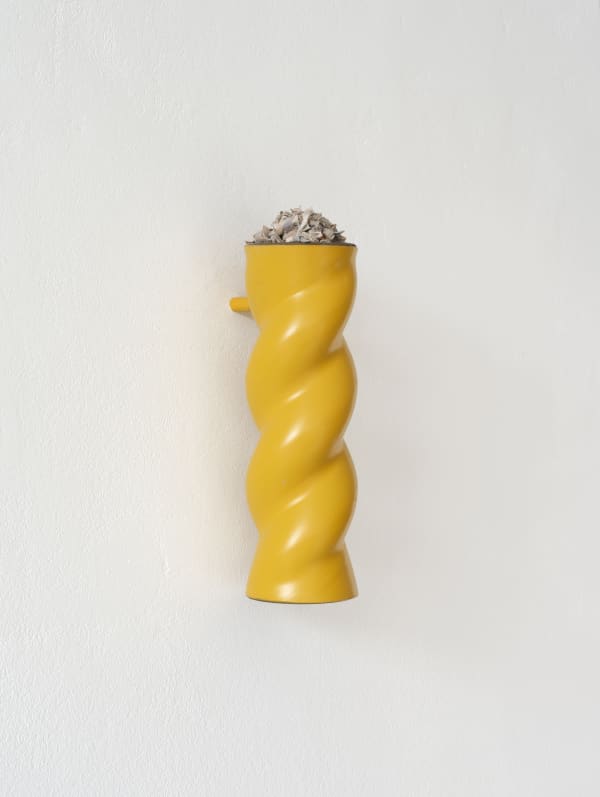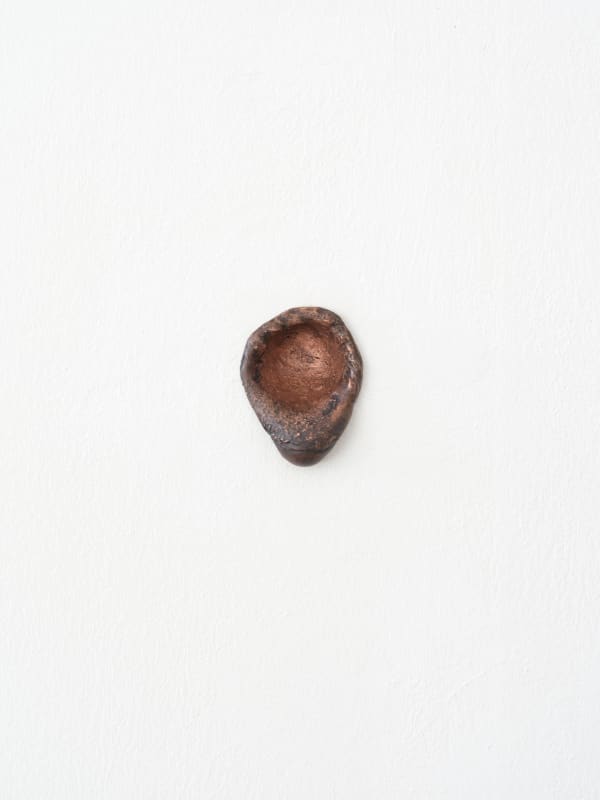Scree Nina Canell
Past exhibition
Overview
Take a room. It’s made of walls, a floor and ceiling. Conceived as stable environments, interior spaces preserve a linear atmosphere: reduced wind speed, absence of dirt and controllable temperatures all make for maintainable enclosures that stand still. We don’t like when things move around without us having moved them around. Nevertheless, they do. As one walks up Rue des Sablons, it’s hard to imagine it as an unused sandy plain. Consider that Sablon (French for “finely ground sand”, or “silt sand”), the district where the gallery is located, was named after the uninhabited wetlands outside of Brussels’s first city walls back in the 13th century. The slope across the road was used as a cemetery upon which the Church of Our Blessed Lady of Sand was built in the 1400s, still visible through the windows today.
Biogeologists sometimes talk about a sense of ‘coeval estrangement’ when a plurality of time and place coalesce in rock as fossils. (1) Nina Canell’s work leans into that plurality by inviting us to consider the durational and material mash-ups that produce the conditions for domesticated environments, and their distinctive moods. Approaching a coeval estrangement of interiors, Canell calls on the immanent energies of material histories to transcend the polished membrane of white walls. A lumpy mixture of cement, carbonated water and crushed shells cling to the gallery’s vertical planes like dehydrated outcrops. (2) Built environments have an insatiable hunger, but within concrete itself is a burning thirst, its caustic inner workings sipping moisture for decades to come.
The marine past of industrial concrete can be traced back through its inexhaustible demand for calcite deposits in sedimentary limestone. At once prehistoric and proto-industrial, two sculptures comprised of concrete mixing vessels have been stacked into large segmented pillars, invoking tumbling as much as the tumbled. Concrete binds much of the built environment, whereas its loose non-adhering aggregates – sand, silt, gravel, mud, scree – are unstable. They impart a sense of ruin: of abandoned walls and roofless structures, a sense of elsewhen, where time and its material scaffold crumbles and leaks back into the world, returning to the weather. In the mineral realm tumbling through uncertain ground is the condition in which to move through the world – slow, granular and eternally open-ended – a steady shattering of linear time.
Scree hones in on the rooms of Rue des Sablons 13, evoking its geological underbelly, grasping for a grainy past within and beyond the conspicuous. It is a subtle subversion of the secular, extractivist conditions that govern our material relations. Under the creaky floorboards, along patches of abandoned piping, Canell’s sculptures try to sense a room within the room, tugging at the seams of certainty.
[1] Sophia Roosth, Turning to Stone: Fossil Hunting and Coeval Estrangement in Montana, Anthropology and Aesthetics, Vol. 69-70, 2018.
[2] The shells derive from the North Sea where they are dredged by the tonne along with sand to feed the construction industry. See: Nina Canell, Shell Reader, published by Bom Dia Boa Tarde Boa Noite and Berlinische Galerie, 2022.
Scree is Nina Canell’s first solo exhibition in Brussels.
Biogeologists sometimes talk about a sense of ‘coeval estrangement’ when a plurality of time and place coalesce in rock as fossils. (1) Nina Canell’s work leans into that plurality by inviting us to consider the durational and material mash-ups that produce the conditions for domesticated environments, and their distinctive moods. Approaching a coeval estrangement of interiors, Canell calls on the immanent energies of material histories to transcend the polished membrane of white walls. A lumpy mixture of cement, carbonated water and crushed shells cling to the gallery’s vertical planes like dehydrated outcrops. (2) Built environments have an insatiable hunger, but within concrete itself is a burning thirst, its caustic inner workings sipping moisture for decades to come.
The marine past of industrial concrete can be traced back through its inexhaustible demand for calcite deposits in sedimentary limestone. At once prehistoric and proto-industrial, two sculptures comprised of concrete mixing vessels have been stacked into large segmented pillars, invoking tumbling as much as the tumbled. Concrete binds much of the built environment, whereas its loose non-adhering aggregates – sand, silt, gravel, mud, scree – are unstable. They impart a sense of ruin: of abandoned walls and roofless structures, a sense of elsewhen, where time and its material scaffold crumbles and leaks back into the world, returning to the weather. In the mineral realm tumbling through uncertain ground is the condition in which to move through the world – slow, granular and eternally open-ended – a steady shattering of linear time.
Scree hones in on the rooms of Rue des Sablons 13, evoking its geological underbelly, grasping for a grainy past within and beyond the conspicuous. It is a subtle subversion of the secular, extractivist conditions that govern our material relations. Under the creaky floorboards, along patches of abandoned piping, Canell’s sculptures try to sense a room within the room, tugging at the seams of certainty.
[1] Sophia Roosth, Turning to Stone: Fossil Hunting and Coeval Estrangement in Montana, Anthropology and Aesthetics, Vol. 69-70, 2018.
[2] The shells derive from the North Sea where they are dredged by the tonne along with sand to feed the construction industry. See: Nina Canell, Shell Reader, published by Bom Dia Boa Tarde Boa Noite and Berlinische Galerie, 2022.
Scree is Nina Canell’s first solo exhibition in Brussels.
Works
-
 Nina Canell, Knock Knock, 2022
Nina Canell, Knock Knock, 2022 -
 Nina Canell, Bubble Cult, 2022
Nina Canell, Bubble Cult, 2022 -
 Nina Canell, Silurian Slurs, 2022
Nina Canell, Silurian Slurs, 2022 -
 Nina Canell, Screee, 2022
Nina Canell, Screee, 2022 -
 Nina Canell, Hardscapes (0,033 Tonnes), 2022
Nina Canell, Hardscapes (0,033 Tonnes), 2022 -
 Nina Canell, Bonfire, 2022
Nina Canell, Bonfire, 2022 -
 Nina Canell, Soft Corner (Visitation), 2016 - 2022
Nina Canell, Soft Corner (Visitation), 2016 - 2022 -
 Nina Canell, Silurian Slurs, 2022
Nina Canell, Silurian Slurs, 2022 -
 Nina Canell, Hardscapes (0,023 Tonnes), 2022
Nina Canell, Hardscapes (0,023 Tonnes), 2022 -
 Nina Canell, Hardscapes (0,017 Tonnes), 2022
Nina Canell, Hardscapes (0,017 Tonnes), 2022 -
 Nina Canell, Hardscapes (0,031 Tonnes), 2022
Nina Canell, Hardscapes (0,031 Tonnes), 2022 -
 Nina Canell, Hardscapes (0,015 Tonnes), 2022
Nina Canell, Hardscapes (0,015 Tonnes), 2022 -
 Nina Canell, Weather Recital, 2022
Nina Canell, Weather Recital, 2022
Installation Views















